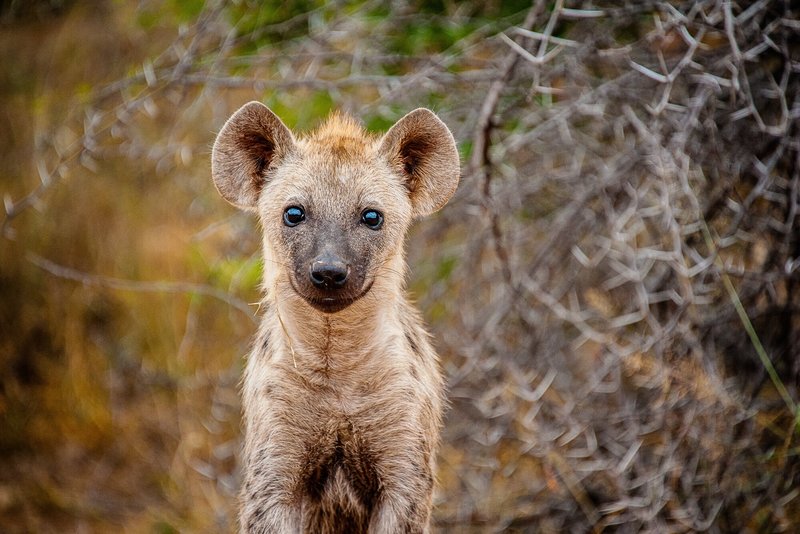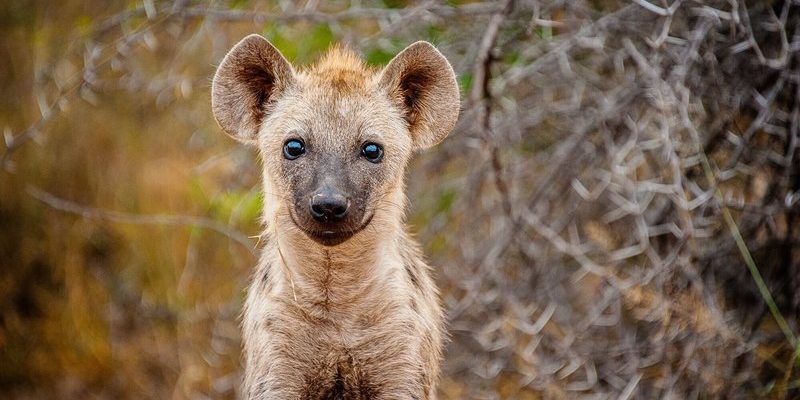
So, let’s dive into the world of the brown hyena and explore ten fascinating facts about this elusive creature. Whether you’re just curious about wildlife or planning a trip to see them in their natural habitat, these facts will open your eyes to the brown hyena’s charm and importance in the ecosystem.
1. Unique Appearance
The brown hyena has a truly distinctive look that sets it apart from its spotted relatives. With a shaggy coat of brownish-black fur that can appear almost scruffy, they have a wild hairstyle that makes them look like they just woke up from a long nap. Honestly, picture a punk rock star in the animal kingdom!
Their large, rounded ears help them hear even the tiniest sounds in their environment. This is crucial for finding food and avoiding danger. Plus, their slender bodies and long legs allow for quick movements, making it easier to navigate their rugged terrain. You might be wondering how these features help them survive. Well, their keen sense of hearing helps them locate carrion—dead animals that are their main food source—before other scavengers arrive.
2. Social Structure
Brown hyenas are fascinating when it comes to their social behavior. Unlike spotted hyenas, which often live in large groups, brown hyenas tend to be more solitary or form loose-knit family units. Picture a small crew of artists sharing a studio but often working on their own masterpieces.
They communicate through a variety of vocalizations, including whoops and growls. You can hear these sounds echoing through the night as they mark their territory. Although they don’t form the tight-knit clans that spotted hyenas do, they do have some social interactions, especially between family members. Anyone who has watched wildlife documentaries knows just how complex these social structures can be, and the brown hyena adds an interesting layer to this narrative.
3. Scavengers by Nature
If there’s one thing the brown hyena excels at, it’s being a scavenger. These animals have earned a reputation for their opportunistic feeding habits. They primarily rely on carrion but will also eat fruits, insects, and small mammals when necessary. This adaptability is crucial for their survival, especially in arid landscapes.
Imagine a restaurant buffet where the brown hyena is always ready to sample whatever leftovers are available. They can smell carrion from several kilometers away, which makes them efficient at locating food. Their role as scavengers is essential for the ecosystem, as they help to clean up the environment by consuming dead animals that could otherwise spread disease.
4. Habitat and Range
Brown hyenas are mostly found in southern Africa, particularly in areas like the Kalahari Desert and the Namib Desert. They thrive in dry, arid regions where few other predators roam. You might picture them as the ultimate survivalists, adapted to some of the harshest conditions on the planet.
While these hyenas can travel long distances in search of food or new territory, they prefer habitats that provide shelter and access to resources. Their choice of home reflects their adaptability. It’s like choosing a cozy corner in a busy café where you can still keep an eye on the pastry counter.
5. Reproduction and Parenting
The mating rituals of brown hyenas are quite fascinating. They tend to have a polygamous approach, where both males and females mate with multiple partners. After a gestation period of about three months, a female typically gives birth to one to four cubs. It’s a relatively small number, which shows how vital it is that these cubs survive in a challenging environment.
Brown hyena mothers are fiercely protective of their young, often staying with them until they’re old enough to fend for themselves. The cubs are born with dark fur, and their colors gradually lighten as they grow. Watching a mother brown hyena care for her cubs is like witnessing a tender moment in a busy world, reminding us of the bonds present in the wild.
6. Conservation Status
Sadly, the brown hyena is considered “Near Threatened” due to habitat loss and human encroachment. As urban developments expand, their natural habitats shrink, making it harder for them to find food and shelter. It’s like watching a favorite restaurant close down because of a new shopping mall—heartbreaking!
Conservation efforts are crucial for their survival. Organizations work to educate communities about the importance of these scavengers in the ecosystem. Protecting their habitats and ensuring they have enough food sources is essential for keeping the brown hyena population stable. It’s a collaborative effort involving wildlife organizations, local governments, and even the communities living alongside these fascinating creatures.
7. Distinctive Diet
Let’s talk about what the brown hyena munches on. These scavengers have a flexible diet, but they primarily feast on carrion. You might be surprised to learn that they can consume up to 15 kilograms (about 33 pounds) of meat in one sitting! Imagine going to a buffet and only being able to fill your plate with leftovers—definitely a unique dining experience!
Not only do they eat dead animals, but they also enjoy fruits and roots. They play a crucial role in the ecosystem by ensuring that carcasses don’t linger too long, which helps reduce the spread of disease. Their unique diet allows them to thrive in environments where other predators might struggle.
8. Adaptations for Survival
Brown hyenas have several adaptations that make them masters of survival. Their thick fur protects them from harsh weather conditions, while their large, sharp teeth allow them to crack open bones to access the nutritious marrow inside. It’s like having built-in tools for survival!
Their keen sense of smell is another incredible adaptation. It helps them detect food from afar, which is vital in the vast, open landscapes they inhabit. Being able to find food easily can mean the difference between life and death, especially in challenging environments.
9. Cultural Significance
In some cultures, brown hyenas are seen as symbols of death and misfortune, partly due to their scavenging habits. However, they also hold a place in folklore and stories, where they are often depicted as cunning tricksters. It’s like having a character in a story who’s misunderstood but adds depth and intrigue to the narrative.
Understanding these cultural perspectives helps us appreciate the brown hyena beyond its ecological role. By shining a light on their uniqueness, we can foster a greater respect for them and their place within our world.
10. The Brown Hyena’s Future
The future of the brown hyena depends on conservation efforts and how we manage human-wildlife interactions. Promoting awareness about their role in the ecosystem is vital for their protection. Just like supporting your favorite local band helps them stay afloat, advocating for the brown hyena can help ensure their survival.
By encouraging sustainable practices and minimizing habitat destruction, we can make a positive impact on their future. It’s essential to remember that every creature has its role in maintaining the balance of nature, and the brown hyena is no exception.
As we’ve seen, the brown hyena is much more than just a scavenger; it’s a unique and vital part of the ecosystem. By understanding these incredible animals and protecting their habitats, we can ensure they continue to thrive for generations to come.

